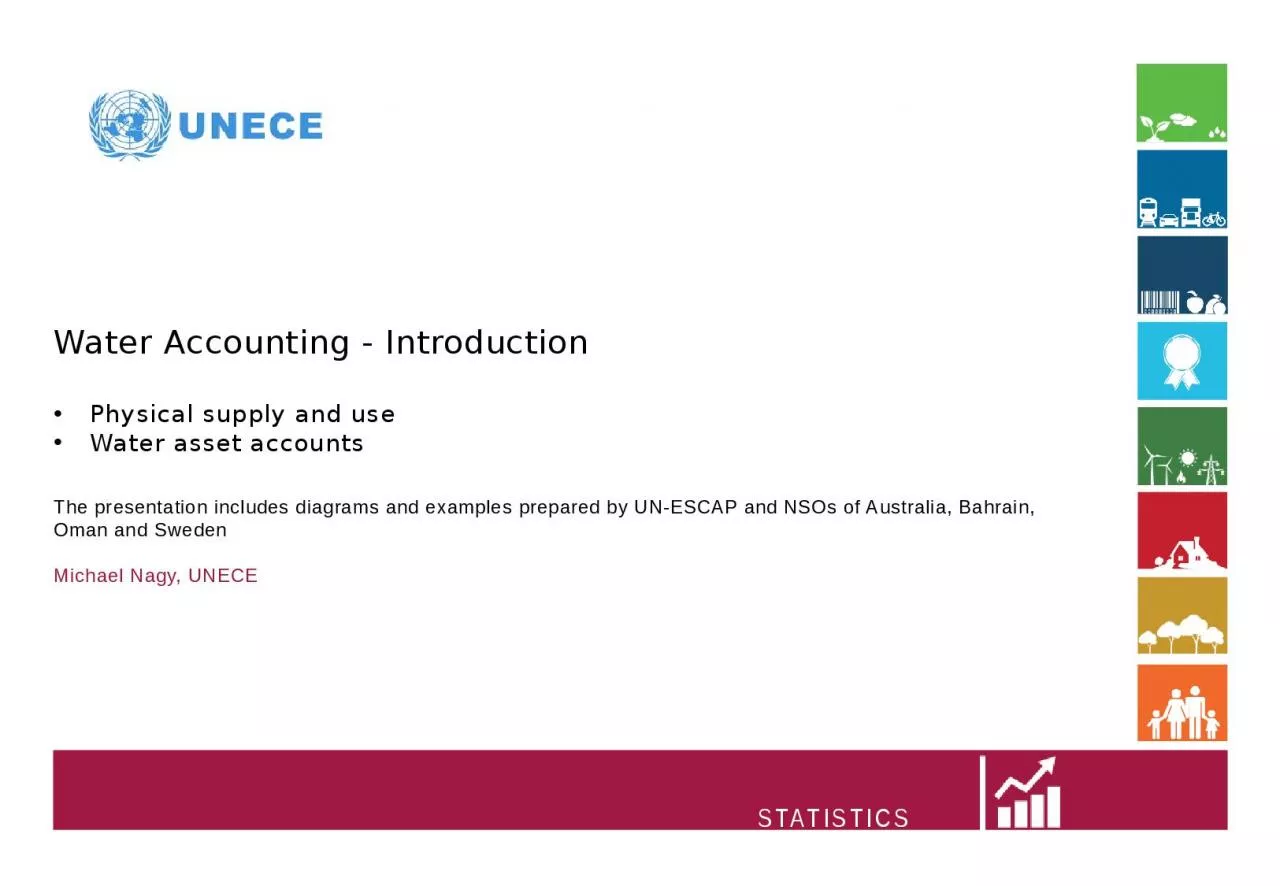

Physical supply and use Water asset accounts The presentation includes diagrams and examples prepared by UNESCAP and NSOs of Australia Bahrain Oman and Sweden Michael Nagy UNECE STATISTICS What ID: 1030002
Download Presentation The PPT/PDF document "STATISTICS Water Accounting - Introducti..." is the property of its rightful owner. Permission is granted to download and print the materials on this web site for personal, non-commercial use only, and to display it on your personal computer provided you do not modify the materials and that you retain all copyright notices contained in the materials. By downloading content from our website, you accept the terms of this agreement.
1. STATISTICSWater Accounting - IntroductionPhysical supply and useWater asset accountsThe presentation includes diagrams and examples prepared by UN-ESCAP and NSOs of Australia, Bahrain, Oman and SwedenMichael Nagy, UNECE
2. STATISTICSWhat?Availability (stocks) and changes (flows) of water resourcesSupply and use of water within the economyWhy?Policies on water security, water resources managementLinks to economic accountsBasis for SEEA-WATER, SEEA-EEAIndicators, e.g.Total water use (by source, purpose, etc.)Water intensity/productivityVariability in water resources, trends (droughts, floods)What and why are we measuring2
3. STATISTICSIndicator 6.1.1: Proportion of population using safely managed drinking water services Indicator 6.2.1: Proportion of population using safely managed sanitation services, including a hand-washing facility with soap and waterIndicator 6.3.1: Proportion of wastewater safely treatedIndicator 6.4.1: Change in water-use efficiency over timeIndicator 6.4.2: Level of water stress: freshwater withdrawal as a proportion of available freshwater resourcesIndicator 6.5.1: Degree of integrated water resources management implementation (0-100)Indicator 6.5.2: Proportion of transboundary basin area with an operational arrangement for water cooperationIndicator 6.6.1: Change in the extent of water-related ecosystems over timeIndicator 6.a.1: Amount of water- and sanitation-related official development assistance that is part of a government-coordinated spending planIndicator 6.b.1: Proportion of local administrative units with established and operational policies and procedures for participation of local communities in water and sanitation management Related SDG IndicatorsGoal 6: Ensure availability and sustainable management of water and sanitation for all. For which ones is water statistics and accounts needed?3
4. STATISTICSKnowing user needsConceptual understanding of water stocks and flowsFamiliar with terms, definitions and classificationsAvailability of basic water statistics and monetary data itemsUnderstanding of main accounting principlesUnderstanding of structure of the water accounting tables.What is important for producers of water accounts?4
5. STATISTICSStock-Flow Model of SEEA WaterSimplified model5
6. STATISTICSStock-Flow Model of SEEA WaterMore detailed model6
7. STATISTICSClassifications:Economic Activities: ISIC rev. 4.0Products: CPC ver. 2Environmental AssetsTerms, definitions, methodological guidanceTerms, definitions and classificationshttps://seea.un.org/content/seea-waterSEEA-Water (2007)IRWS (2012)Methodological Guidelines (2014)Technical Note (2017)7SEEA CF (2014)
8. STATISTICSWhat is measured?Stock of water at the beginning and end of an accounting periodFlows of water:Abstracted by the economyReturned by the economyAdded through precipitationEvaporated and evapo-transpiratedChanges through flows between different water resourcesWater assets:1. Surface water1.1 Artificial reservoirs1.2 Lakes1.3 Rivers and streams1.4 Glaciers, snow and ice2. Groundwater3. SoilwaterWater Asset AccountsWhat do we measure for each water asset?8
9. STATISTICSUnderstanding Water Asset AccountsThe Hydrological Cycle9
10. STATISTICSUnderstanding Water Asset AccountsWater asset account diagram10
11. STATISTICSUnderstanding Water Asset AccountsWater asset account (from diagram)11SEEA-CF - Water accounts
12. STATISTICSUnderstanding of physical flow accountsImportant concepts: be aware that the same terms may be used differently by others!12 Economic activity/HouseholdsUseFrom the environment (abstraction)From another economic unitEvapotranspirationConsumption(Accummulation)Consumption(Flow to the environment)SupplyTo the environment (returns)To another economic unitSupply
13. STATISTICSUnderstanding of physical flow accountsWater flow diagram13 Water Supply IndustryAgriculture, Forestry, FishingMining, quarrying, manufacturing, constructionElectricity, gas, steam, air conditioningOtherHouseholdsInland Water Resources: 437.4Other Water Resources: 2.1439.5Losses: 47.3Wastewater: 1.4Evaporation: 1.838.745.03.951.1250.3389.03.1
14. STATISTICSUnderstanding of physical flow accountsPhysical supply table14
15. STATISTICSUnderstanding of physical flow accountsPhysical supply table15
16. Understanding of physical flow accountsPhysical use table16
17. Understanding of physical flow accountsPhysical use table17
18. STATISTICSPhysical Asset Accounts and PSUTThey are linked with each other18Linked with PSUTLinked with PSUT
19. Example for a combined presentation for waterCombining physical and monetary data19
20. STATISTICSSome water accounting examples from around the worldAustralia20
21. Inland Water ResourcesWater SupplyISIC 36SewerageISIC 37HouseholdsElectricityISIC 35Mining*ISIC 5-9Manufacturing*ISIC 10-33AgricultureISIC 1Other ISIC 2,3,38,39, 45-99???38559924110227????2045529246601728622323417253296582556115???57718743811160280613778?2The Sea1232KeyWastewaterWaterReuse water0* Note shown is the supply of distributed water and reuse water by mining and manufacturing, 25 GL in total.Example Australia – physical water supply and use, 2004-05 (GL)
22. Inland Water ResourcesWater SupplyISIC 36SewerageISIC 37HouseholdsElectricityISIC 35Mining*ISIC 5-9Manufacturing*ISIC 10-33AgricultureISIC 1Other ISIC 2,3,38,39, 45-9997772???????55252??????23253291?69891????2147???????2357?The Sea?KeyWastewaterWaterReuse water* Note shown is the supply of distributed water and reuse water by mining and manufacturing, 25 GL in total. No monetary available for these.Example Australia – monetary water supply and use, 2004-05 (million AUD$)
23. Example Australia: Monetary versus physical use of distributed water (% of total use)23Physical useMonetary use
24. Percentage of mean annual rainfall1998-99 to -2000-01Percentage of mean annual rainfall2002-03 to -2004-05Australia: Analysing changes over time
25. Projecting future water demands: Australia 205025
26. Modelling Effects of Price Changes:Murray-Darling River Basin AustraliaBased on historical water use & price data, simulated impact on GDP of doubling water prices and the expected increases in water use efficiency (WUE) of 1-2%
27. STATISTICSSome water accounting examples from around the worldPilot water accounts for Oman and Bahrain27
28. STATISTICSSome water accounting examples from around the worldOman: Trial population of physical supply and use diagram28
29. STATISTICSSome water accounting examples from around the worldBahrain: Trial population of physical supply and use diagram29
30. STATISTICSSome water accounting examples from around the worldSweden: Environmental Economic Profiles (1995)30
31. STATISTICSSome water accounting examples from around the worldSweden: Water use by sectors (2010)31
32. STATISTICSMichael NagyUNECE Thank you!